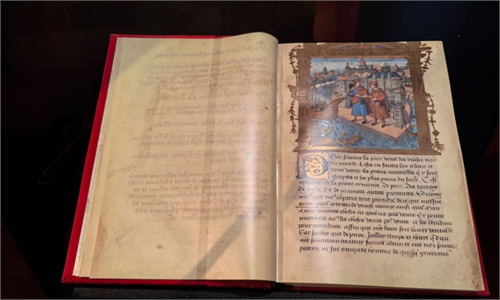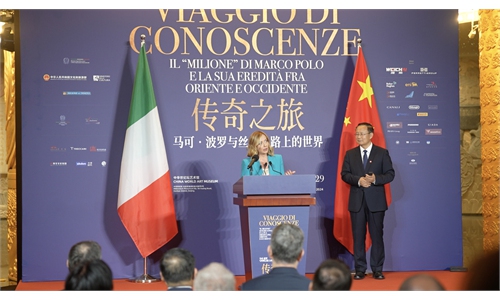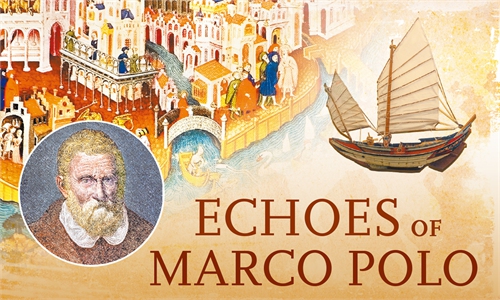ARTS / CULTURE & LEISURE
Exhibition revives legend connecting East and West
After 700 years, Marco Polo still relevant
Italian Prime Minister Giorgia Meloni attended the opening of an exhibition paying tribute to Marco Polo at the China Millennium Monument in Beijing on Monday as part of her first state visit to China since she took office.
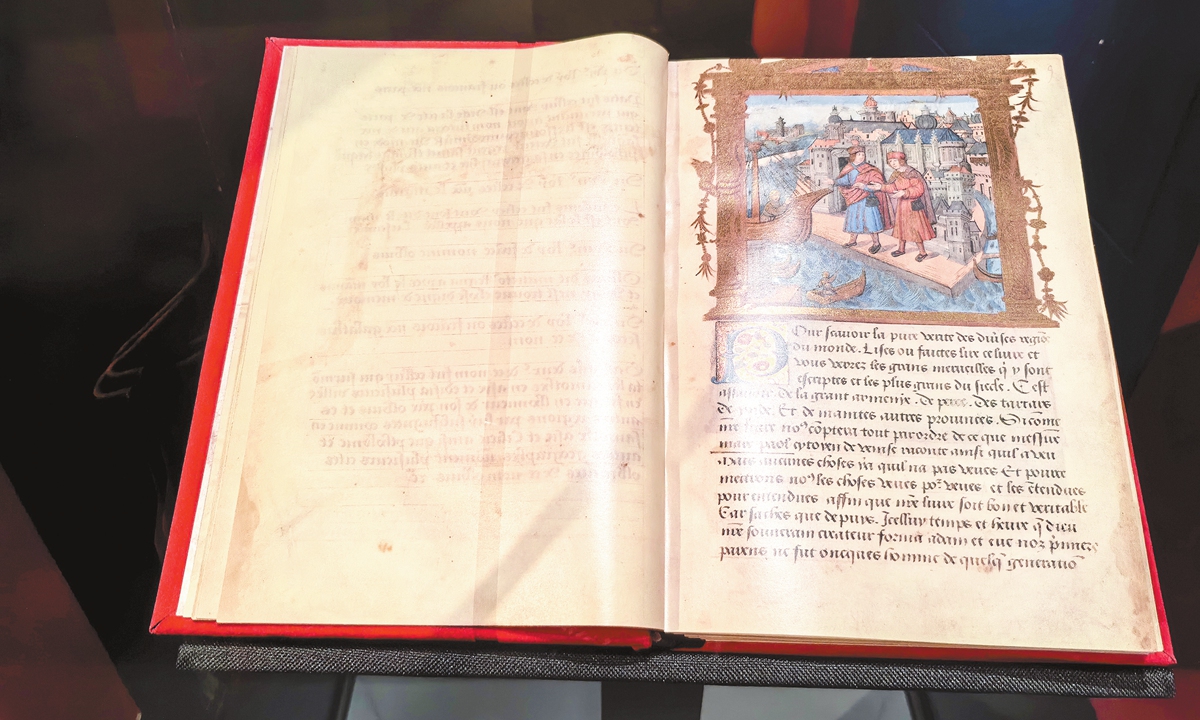
Marco Polo, an Italian merchant, traveler and storyteller, is still remembered by the world and still relevant to our lives. He is remembered and commemorated today not just because he traveled far, but rather because of the stories he told us from his unique and curious perspective.
Titled A Journey of Knowledge: The travels of Marco Polo and its legacy between East and West, the exciting new exhibition features over 130 artifacts sourced from 15 museums in both China and Italy. Split into six thematic sections, the exhibition showcases a rich array of artifacts, including manuscripts, oil paintings, sculptures, jewelry, ceramics, coins, glass items, textiles, as well as a VR experience, all telling the captivating story of Marco Polo, the legendary Venetian explorer.
Italian Ambassador to China Massimo Ambrosetti emphasized the long-standing friendship between Italy and China during an interview on Friday. He highlighted the significance of the exhibition as a means to strengthen these ties. Events like the 700th anniversary of Marco Polo's death serve to rein-force the interconnectivity of the civilizations and the importance of cultural dialogue for future col-laboration.
"These exhibitions, these cultural events underline that our links are very ancient, our civilizations are very inter-connected since ancient times. What's important is today, we are able to develop these ancient links for the future," he stressed..
Firsts in exhibition
Guicciardo Sassoli de Bianchi, an art historian and project curator with the Italian Institute of Culture in Beijing, emphasized the importance of this rare collaborative effort.
"This is the first time so many Italian and Chinese museums have come together for a single exhibition. We gathered 13 different Italian museums to curate the best artworks that narrate Marco Polo's story through art," he told the Global Times.
While most exhibitions are typically organized by a single museum, this one involved a collaborative effort from the Italian Embassy in China, the Italian Institute of Culture and two Chinese museums.
Sassoli de Bianchi described this cooperation as "a symbolic way to explain how the exchange of civilizations happened." By "telling history through objects," the exhibition transports visitors back to 13th-century Venice, allowing them to explore aspects of its history, religion, commerce, warfare, and knowledge up to the 20th century.
Marco Polo's travels and his seminal work, Travels in the Land of Kublai Khan, exemplify a significant phase of global interaction between the East and West, deepening European understanding of far-off kingdoms, particularly China and recreating an ideal journey along Marco Polo's historic route.
"We wanted visitors to experience Marco Polo's travels through geography and his narratives in the book. We explore how the Western world perceived the East without direct travel, relying instead on Polo's writings and maps," Giorgia Cestaro, project curator at the Italian Embassy in Beijing, told the Global Times.
Cestaro highlighted some of the exquisite artifacts on display, including remarkable silk and porcelain wares from the Yuan Dynasty.
As visitors wander through the 890-square-meter exhibition, they are guided through a journey encompassing Western influences to Eastern aesthetics.
Joseph Dejardin, designer for the Marco Polo exhibition, explained that the evolving architecture guides this journey.
"We wanted to illustrate how Venice, influenced by its global trade relationships, transformed its architectural styles, blending Western and Eastern elements," he said.
Citing British art historian John Ruskin's work, The Stones of Venice, Dejardin elaborated on the architectural inspirations behind the design, emphasizing how the doorways reflect Venice's rich exchange with diverse cultures.
After visiting the exhibition, professor Cheng Mo from Peking University told the Global Times that the immersive environment successfully evokes the exotic world Marco Polo traveled through. He highlighted how the layout aids in imagining Marco Polo's life and enjoying the familiar artifacts from Central Asia and China, creating a time travel journey for visitors.
As visitors delve into this extraordinary exhibition, they embark on a captivating exploration of cultural exchanges and legacy, celebrating a timeless connection between East and West through one of history's most revered travelers.
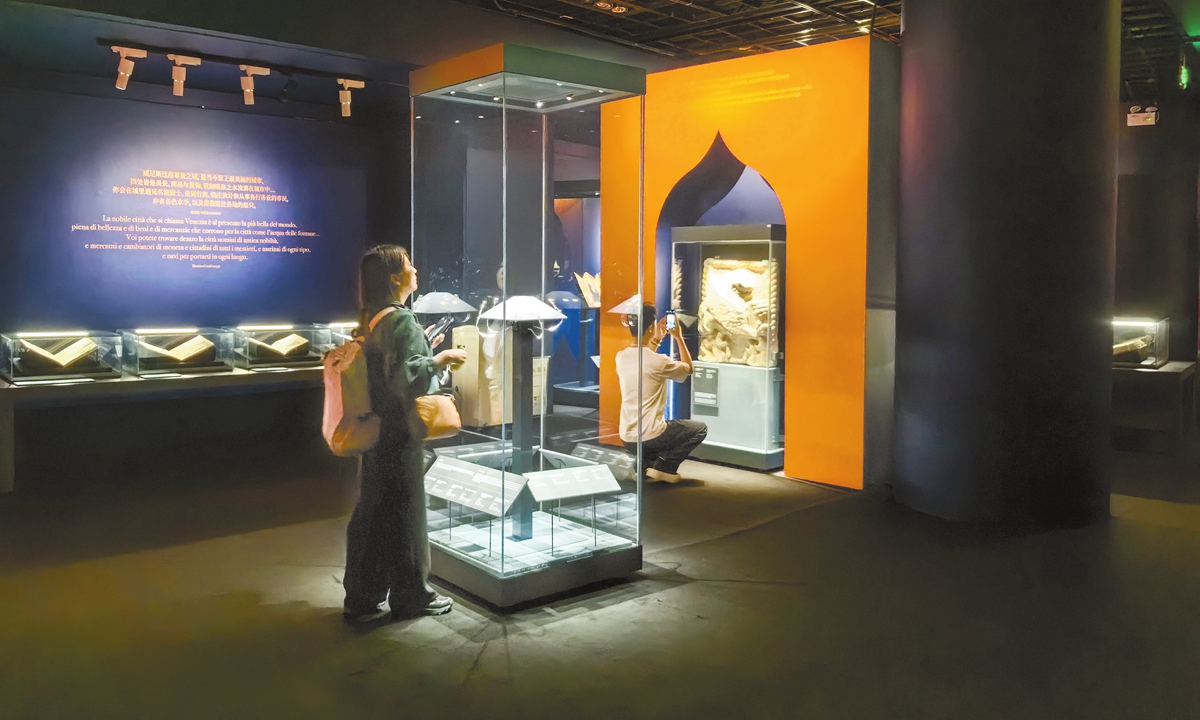
Marco Polo was a bridge, a bridge for both realities, and today that bridge is an example of what a single man can build and pass on.
"In this bas-relief there are only two foreigners depicted, and they are both Italian: The first is Marco Polo. The second is Matteo Ricci. If Marco Polo introduced China to Westerners, Matteo Ricci helped the Chinese people open their horizons and understand Europe and the West," said Meloni at the inauguration ceremony.
Scientific Director of the Fondazione Musei Civici di Venezia Chiara Squarcina said in a lecture on Friday, Marco Polo told stories "in a completely respectful approach, devoid of will conditioned by paradigms and stereotypes, which has allowed us to carry up to the present a vision absolutely free from pollution and preconceptions."
There is a deep difference between him and Matteo Ricci, a Jesuit who remained at the Imperial Court for many years. The Jesuits sought to convert people to Christianity through cultural exchange. Marco Polo did not want to convert people but to understand them; he did not want to impose his knowledge, rather he wanted to learn; he wanted to see and understand. Marco Polo and travelers in general are an example of inclusiveness, Squarcina noted.
Federico Antonelli, cultural counselor of the Italian embassy in China, told the Global Times that the Italian Cultural Institute of Beijing has been rolling out diverse activities to promote Italian culture in China, commemorating the 700th anniversary of Marco Polo's death.
In addition to the exhibition, the Italian Cultural Institute of Beijing has republished Invisible Cities, a book by Italo Calvino that consists of a sequence of imaginary dialogues between the Marco Polo and Kublai Khan.
In the course of these discussions, the young Marco Polo describes a series of metropolises, each of which bears a woman's name, and each of which is radically different from all the others and from any real-world city.
For children, a comic based on the Chinese translation of the book titled Geronimo Stilton - A Thousand Wonders: A Journey to Discover Italy, has also been published in China.
From February to May, the Italian Cultural Institute of Beijing screened the very first TV series involving cooperation between a Chinese film studio, the Beijing Film Studio, and a foreign television station, Radiotelevisione Italiana (RAI): Marco Polo. Despite being produced in 1982, it still managed to fascinate audiences.
Following Marco Polo's footsteps, a photography exhibition by Italian ANSA news agency that displays how the places he visited looked then and now has been held in different cities, including the Hong Kong Special Administrative Region, Beijing and Chongqing, Antonelli introduced.
"Marco Polo's stories still inspire us to travel today," Antonelli said. As a merchant, his perspectives told us that as early as more than 700 years ago, the world economy was integrating, indicating the importance of mutual understanding and respect, which we should bear in mind.

Le devisement do monde (The Development of the World), one of the exhibits at the exhibition, provides signposting for visitors to navigate through the route that Marco Polo traveled over his life. Photos: Dong Feng/GT
The year 2024 carries dual significance as this year marks both the 700th anniversary of Marco Polo's death and the 20th anniversary of the China-Italy comprehensive strategic partnership.Marco Polo, an Italian merchant, traveler and storyteller, is still remembered by the world and still relevant to our lives. He is remembered and commemorated today not just because he traveled far, but rather because of the stories he told us from his unique and curious perspective.
Titled A Journey of Knowledge: The travels of Marco Polo and its legacy between East and West, the exciting new exhibition features over 130 artifacts sourced from 15 museums in both China and Italy. Split into six thematic sections, the exhibition showcases a rich array of artifacts, including manuscripts, oil paintings, sculptures, jewelry, ceramics, coins, glass items, textiles, as well as a VR experience, all telling the captivating story of Marco Polo, the legendary Venetian explorer.
Italian Ambassador to China Massimo Ambrosetti emphasized the long-standing friendship between Italy and China during an interview on Friday. He highlighted the significance of the exhibition as a means to strengthen these ties. Events like the 700th anniversary of Marco Polo's death serve to rein-force the interconnectivity of the civilizations and the importance of cultural dialogue for future col-laboration.
"These exhibitions, these cultural events underline that our links are very ancient, our civilizations are very inter-connected since ancient times. What's important is today, we are able to develop these ancient links for the future," he stressed..
Firsts in exhibition
Guicciardo Sassoli de Bianchi, an art historian and project curator with the Italian Institute of Culture in Beijing, emphasized the importance of this rare collaborative effort.
"This is the first time so many Italian and Chinese museums have come together for a single exhibition. We gathered 13 different Italian museums to curate the best artworks that narrate Marco Polo's story through art," he told the Global Times.
While most exhibitions are typically organized by a single museum, this one involved a collaborative effort from the Italian Embassy in China, the Italian Institute of Culture and two Chinese museums.
Sassoli de Bianchi described this cooperation as "a symbolic way to explain how the exchange of civilizations happened." By "telling history through objects," the exhibition transports visitors back to 13th-century Venice, allowing them to explore aspects of its history, religion, commerce, warfare, and knowledge up to the 20th century.
Marco Polo's travels and his seminal work, Travels in the Land of Kublai Khan, exemplify a significant phase of global interaction between the East and West, deepening European understanding of far-off kingdoms, particularly China and recreating an ideal journey along Marco Polo's historic route.
"We wanted visitors to experience Marco Polo's travels through geography and his narratives in the book. We explore how the Western world perceived the East without direct travel, relying instead on Polo's writings and maps," Giorgia Cestaro, project curator at the Italian Embassy in Beijing, told the Global Times.
Cestaro highlighted some of the exquisite artifacts on display, including remarkable silk and porcelain wares from the Yuan Dynasty.
As visitors wander through the 890-square-meter exhibition, they are guided through a journey encompassing Western influences to Eastern aesthetics.
Joseph Dejardin, designer for the Marco Polo exhibition, explained that the evolving architecture guides this journey.
"We wanted to illustrate how Venice, influenced by its global trade relationships, transformed its architectural styles, blending Western and Eastern elements," he said.
Citing British art historian John Ruskin's work, The Stones of Venice, Dejardin elaborated on the architectural inspirations behind the design, emphasizing how the doorways reflect Venice's rich exchange with diverse cultures.
After visiting the exhibition, professor Cheng Mo from Peking University told the Global Times that the immersive environment successfully evokes the exotic world Marco Polo traveled through. He highlighted how the layout aids in imagining Marco Polo's life and enjoying the familiar artifacts from Central Asia and China, creating a time travel journey for visitors.
As visitors delve into this extraordinary exhibition, they embark on a captivating exploration of cultural exchanges and legacy, celebrating a timeless connection between East and West through one of history's most revered travelers.

Visitors explore at the exhibition titled A journey of knowledge: The travels of Marco Polo and its legacy between East and West, which was inaugurated at the China Millennium Monument in Beijing on July 29, 2024.
Bridge to better futureMarco Polo was a bridge, a bridge for both realities, and today that bridge is an example of what a single man can build and pass on.
"In this bas-relief there are only two foreigners depicted, and they are both Italian: The first is Marco Polo. The second is Matteo Ricci. If Marco Polo introduced China to Westerners, Matteo Ricci helped the Chinese people open their horizons and understand Europe and the West," said Meloni at the inauguration ceremony.
Scientific Director of the Fondazione Musei Civici di Venezia Chiara Squarcina said in a lecture on Friday, Marco Polo told stories "in a completely respectful approach, devoid of will conditioned by paradigms and stereotypes, which has allowed us to carry up to the present a vision absolutely free from pollution and preconceptions."
There is a deep difference between him and Matteo Ricci, a Jesuit who remained at the Imperial Court for many years. The Jesuits sought to convert people to Christianity through cultural exchange. Marco Polo did not want to convert people but to understand them; he did not want to impose his knowledge, rather he wanted to learn; he wanted to see and understand. Marco Polo and travelers in general are an example of inclusiveness, Squarcina noted.
Federico Antonelli, cultural counselor of the Italian embassy in China, told the Global Times that the Italian Cultural Institute of Beijing has been rolling out diverse activities to promote Italian culture in China, commemorating the 700th anniversary of Marco Polo's death.
In addition to the exhibition, the Italian Cultural Institute of Beijing has republished Invisible Cities, a book by Italo Calvino that consists of a sequence of imaginary dialogues between the Marco Polo and Kublai Khan.
In the course of these discussions, the young Marco Polo describes a series of metropolises, each of which bears a woman's name, and each of which is radically different from all the others and from any real-world city.
For children, a comic based on the Chinese translation of the book titled Geronimo Stilton - A Thousand Wonders: A Journey to Discover Italy, has also been published in China.
From February to May, the Italian Cultural Institute of Beijing screened the very first TV series involving cooperation between a Chinese film studio, the Beijing Film Studio, and a foreign television station, Radiotelevisione Italiana (RAI): Marco Polo. Despite being produced in 1982, it still managed to fascinate audiences.
Following Marco Polo's footsteps, a photography exhibition by Italian ANSA news agency that displays how the places he visited looked then and now has been held in different cities, including the Hong Kong Special Administrative Region, Beijing and Chongqing, Antonelli introduced.
"Marco Polo's stories still inspire us to travel today," Antonelli said. As a merchant, his perspectives told us that as early as more than 700 years ago, the world economy was integrating, indicating the importance of mutual understanding and respect, which we should bear in mind.

